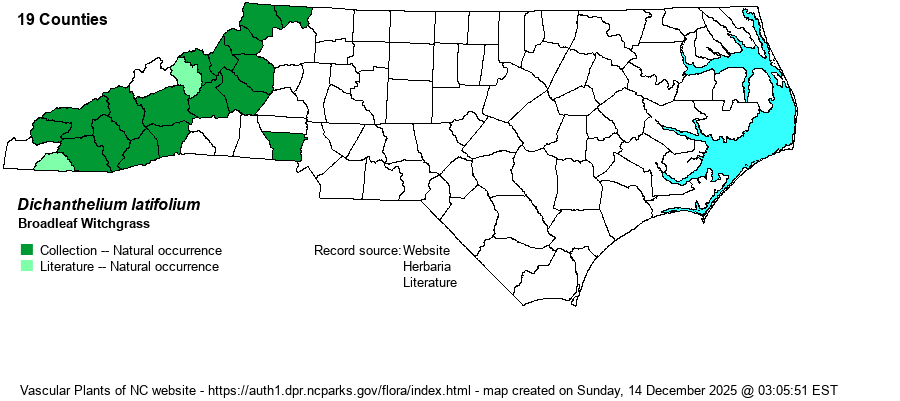| Author | (L.) Harvill | |
| Distribution | Mountains and upper Piedmont only; mostly at the middle and higher elevations.
ME to WI, south to GA and MS. | |
| Abundance | Fairly common in the Mountains, but rare into the western Piedmont. | |
| Habitat | Mixed conifer-hardwood and hardwood forests. | |
| Phenology | Flowering and fruiting late May-September. | |
| Identification | Broadleaf Witchgrass is relatively robust; the stems are 1-3 feet tall and its well-spaced leaves are 15-40 mm wide. Its gestalt is much like that of Bosc's Witchgrass (D. boscii), but the stem nodes are glabrous or sparsely bearded (vs. densely bearded in that species). Robust plants of D. commutatum may approach it in dimensions, but its spikelets are shorter (2.2-3.2 mm long vs. 2.9-3.9 mm long in D. latifolium). | |
| Taxonomic Comments | In older texts named as Panicum latifolium.
A note about Dichanthelium: This genus is not impossible to identify to species! But it takes applied effort over a period of time in order to learn the various species and what their morphological limits are. We strongly recommend that you read the introduction to the treatment in Weakley et al. (2023), written by Richard LeBlond. LeBlond has made order out of near chaos, and his keys work very well for our plants. Most Dichanthelium taxa ("Dichs") do not grow everywhere indiscrimminately, but prefer certain well-defined habitats. Note that most species produce flowers/fruits twice a year -- a vernal period and an autumnal period -- and that measurements of spikelets and achenes are taken from vernal plants. Some species also have a third, or summer, period. In the vernal period there is a single inflorescence at the tip of the stem. In the autumnal period, plants produce elongate branches with bunched (congested) leaves and so look quite different from vernal plants. Inflorescences are produced in leaf axils as well as at the tips of branches. NOTE: Older texts had these species essentially all within the very large genus Panicum. "Dich" species are typically named as "Witchgrass" and Panicum species named as "Panicgrass". | |
| Other Common Name(s) | Broadleaf Rosette-grass | |
| State Rank | S3 | |
| Global Rank | G5 | |
| State Status | | |
| US Status | | |
| USACE-agcp | FACU link |
| USACE-emp | FACU link |

